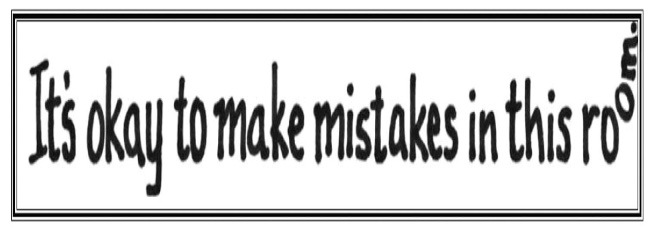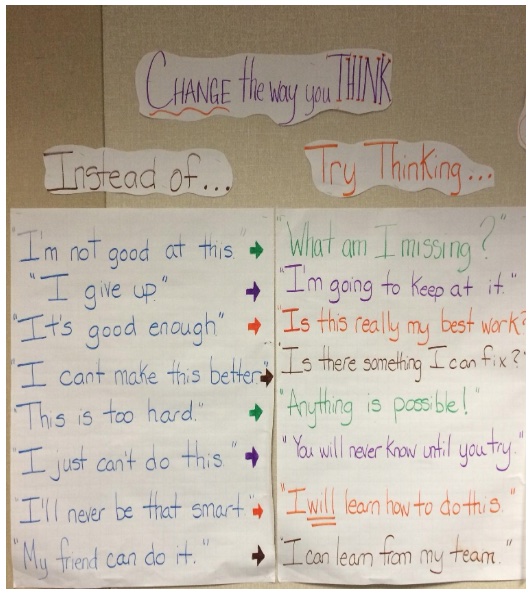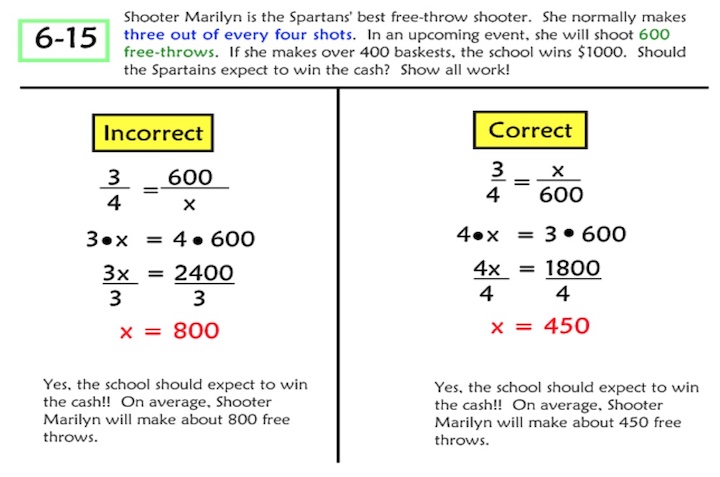Mark Coté, CPM Project Manager
Effective teaching of mathematics consistently provides students, individually and collectively, with opportunities and supports to engage in productive struggle as they grapple with mathematical ideas and relationships.
— NCTM, Principles to Actions (pg. 48)
Learning and making mistakes are inherently intertwined; you cannot have one without the other. But how do we support “productive struggle” for our students as they take conceptual wrong turns or get sidetracked with procedural errors on the road to a deeper understanding of the mathematics? All too often, the learning process is coupled with feedback that creates undermining emotional baggage. With the very first corrected math test comes a student’s valuation of proficiency based on a raw score or percentage. How will the mistakes be perceived? Will students develop feelings of success or failure, pleasure or frustration, esteem or shame? Can teachers do more to promote productive struggle than simply report the ratio of mistakes to attempts?
Fortunately, the answer is a resounding “Yes!” Through deliberate and diligent action, teachers can change a student’s perception of mistakes. Teaching Redesign Corps members Alycia Clarkson, Michael Huler, Tanya Lantrip and Penny Smits have spent the past ten months investigating the mindset of making mistakes while seeking strategies that will create a classroom culture supportive of productive struggle. Early on, they realized this would be no simple task. After all, aren’t people who make lots of mistakes destined for failure? We live in a culture that celebrates the successful final outcome – a Nobel Prize, winning an election, the Super Bowl trophy – but pays little attention to the countless hours of trial and error, prolific practice, and resolve to overcome daunting setbacks that form the basis for an accomplishment. Most students never know about all the mistakes that had to come first before the goal could be realized.
The initial step of their investigation involved tapping into the students’ feelings about making mistakes while learning mathematics. The team made observations and interviewed students during the first two months of the school year, then recorded what happened when miscues were tallied, totaled, and translated into grades. Alycia Clarkson summarized an initial insight. “Turns out our students have some pretty strong feelings about making mistakes, and those feelings bleed over to feelings about themselves.” The perceptions shared by the vast majority of students were that mistakes act like a neon sign advertising failure to achieve. They were seen as a source of embarrassment and often resulted in feelings of sadness, frustration, and anger. For some, years of unsupported struggle in math classes resulted in despair and a desire to throw in the towel. The consensus was you are either born math smart or you are not, and the smart kids do not make mistakes, experience frustration, or have to work hard to earn the rewards of achievement

With a better understanding of their students’ perceptions of mistakes, the team quickly realized that a cultural shift was required; students must be willing to investigate mistakes as opportunities for learning and not as the inevitable outcome of a futile effort to understand mathematics. To combat the feelings of fear, shame and guilt, the TRC members set an instructional agenda to change mindsets. They called upon the expertise of Carol Dweck and Jo Boaler, employing several resources from their websites (mindsetnetworks and youcubed.org ) to teach about the physiology of the brain and neuroplasticity. Students were amazed to learn that brains actually grow and develop more, not when all their work was correct, but when mistakes were made and investigated. The teachers integrated small doses of the brain information into the curriculum during the first few months of instruction, and offered brief refreshers throughout the year.
Next came an examination of self-talk, both student and teacher. For the former, much of the negativity associated with mistakes was often reinforced by knee-jerk self-criticism. In previous years, it was not uncommon for the teachers to hear negative remarks like these after handing back tests: “I always get it wrong,” “I can’t learn this stuff,” and “Why try?”
This year would be different. From the start, students were asked to examine old habits, consider how counterproductive negative self-talk could be, and adopt a new mindset about learning. To support this effort, the TRC investigators engaged in a comprehensive, but low-key, advertising campaign, which included the following:

- Altering the classroom environment by creating bulletin boards rich with growth mindset oriented words and phrases that the students used to replace the negative self-talk.
- Modeling of positive self-talk and encouragement to unleash the power of “Yet!” so that “I don’t get this!” becomes “I don’t get this, yet!”
- Sharing growth mindset related videos and stories from the media along with personal anecdotes about overcoming obstacles through struggle.
- Introducing a new growth mindset meme each week as a stimulus for a brief conversation, known as Mindset Mondays.
- Reading short excerpts from books that embrace miscues such as Mistakes That Worked by Charlotte Jones and John O’Brien.
Along with this thorough student immersion in mindset vernacular came the charge to modify teacher talk. As Michael Huler pointed out, “This is not just another chapter in the self-esteem movement. The days of offering praise for demonstrated ability and simple task completion are behind us. How we as teachers talk in the classroom is a big concern. Shifting our language pattern to reflect the level of effort involved in the learning process and to prompt challenge is a tough change.” To make this shift, the teachers brainstormed ideas about learning from mistakes, then captured words and phrases they could use during circulation. A key strategy was to avoid carpet-bombing the students with constant word choice corrections and seek a more subtle, organic method. As they moved from team to team, the teachers made a conscious effort to listen for “mistake talk” and responded with process praise, encouragement to keep trying, and questions that demonstrated a sincere desire to understand the error. The TRC investigators reported that it took about four months for teacher talk adjustments to feel natural and routine.
With the goal of changing perceptions, four instructional strategies for processing errors were implemented because, to paraphrase French writer Antoine de Saint-Exupery, a desire to improve and learn from mistakes without a plan is just wishful thinking. And the general consensus from experts on mindset is that offering simple, shallow directives like, “Try harder” and “Correct your work” are less effective than saying nothing at all. The TRC team put the following procedures into action in their classrooms during the past nine months.
1. Treat “real” mistakes with respect. As is often the case, a good portion of a team’s solution to a problem contains loads of great mathematical thought even though the final answer may be incorrect. To prompt students to look for and celebrate what went well instead of discarding a sound effort and starting over, one team’s work was (anonymously) put under the document camera for examination by the class. The work selected had a complete solution, but also included the most common error(s) shared by the entire class. Teams were asked to identify where the mathematical thinking took a wrong turn and then discuss why that might have happened. Next, they were prompted to craft questions that would help a student actually figure out what they missed and fix it on their own. A variation of this mistake analysis exercise involved handing a team an unnamed student’s solution to a problem. Teams were asked to highlight everything that was mathematically correct, articulate the basis for the error, make the correction, and note key understandings that need to be remembered for the next effort on this type of problem. Orchestrating such a dialogue about what can be learned from the few “real” mistakes that occurred permanently changed the study team routine for fixing warm-ups, quizzes, classwork, homework, and test problems. Students learned to look for and find the “right” in the middle of the “wrong”. As far as offering advice for self-improvement, Alycia noted, “They were pretty hard on themselves and, as it turns out, not very good at this. But they were a little more articulate, kind, and helpful when analyzing someone else’s mistake and making recommendations.”
2. Create mistakes for a purpose. To elevate the level of engagement, several investigators turned the tables as they introduced The Mistake Game to their students. This activity tasked teams to create a purposeful and treatment-worthy mistake as part of the solution to a problem selected from a given lesson. Teams were required to make a clear, concise presentation of the problem, walking the class through the steps while acting as if everything was done correctly so as not to give away the miscue. In response, the class was directed to understand the problem, detect the mistake, and ask the presenters questions to help them self-correct. During the debrief following the activity, teams shared ideas about what constituted a “good” challenging mistake. They also debated the effectiveness of the questions that were asked to the presenting team. The Mistake Game provided yet another opportunity for formative assessment; students had to demonstrate adequate knowledge of the content in order to create an error worth investigating. And in the process of doing this, they had fun.
3. Practice finding and fixing mistakes. To accomplish this goal, the investigators made new use of the Review & Preview sections from the CPM textbooks by creating solution sets that contained a single mistake. To check the previous evening’s homework, each team received two copies of the solution set and one mistake analysis sheet. After the students compared answers and engaged in some vigorous debate about which problem contained the error, the single mistake was discovered. Next, the Recorder/Reporter wrote out the culprit problem on the analysis sheet, showing all of the work included in the solution set. Next, the Facilitator pinpointed where the mistake occurred by highlighting it. Then the Task Manager recorded the team’s agreed upon correction, showing all the work. Finally, the Resource Manager recorded the advice the team would offer to the hypothetical student who made this error. For teams that struggled beyond the allotted time, a “reveal” sheet was included (shown below for problem 6-15 from Core Connections, Course 3.) Penny Smits summarized the results: “What we found is that when embedding mistakes in the homework, the numerous positives are worth the time it takes to create the answer keys and train the students in the process. We observed increased discourse among teams and a notable gain in the usage of correct mathematical vocabulary. Students reported an elevated sense of purpose for doing the homework and enjoyed feeling challenged to find the mistake. Each embedded mistake made for a low floor – high ceiling activity, which prompted a very inclusive class discussion and an additional opportunity to learn about multiple strategies. Finally, teacher flexibility to embed a mistake and individualize it to their own set of classes was the icing on the cake.”

4. Use “exam wrappers” to provide descriptive effective feedback on assessments. Altering grading policies to support productive struggle was found to be one of the major challenges facing the team. But this had to be done so that students would do more with a returned test than give it a cursory look and drop it in the nearest recycle bin. Turning mistakes into learning opportunities following a major test was the goal for implementing “exam wrappers”, a strategy created by Marsha Lovett, director of the Eberly Center for Teaching Excellence and Educational Innovation at Carnegie Mellon University. This simple strategy involves wrapping a returned test with a piece of paper that prompts reflection. Students were asked to acknowledge the mistakes, categorize the reason(s) for the errors, make corrections, and report lessons learned. Tanya Lantrip was highly encouraged by the comments from her students. “They acknowledged that it’s okay to make mistakes as long as they learn what they did wrong and try to improve on the re-take. When I hear, ‘Now I know what I need to do for my next test’, I know we’ve had an effect on learning and attitude.”
This TRC study has already had an impact beyond the investigator’s own classrooms. Feedback from the standing-room-only crowd at the 2016 CPM National Conference in February was similar to the following. “This was my favorite session. The activities were something I could implement immediately in my classroom on Monday morning. I really learned how to change myself and my class culture to foster a growth mindset where learning is 100% student centered. Excellent presentation. I’m inspired!!!”
TRC 3.0 will launch soon to investigate new ideas for improvement. If you are interested in applying for space on the team, please email us at research@cpm.org.
